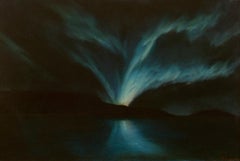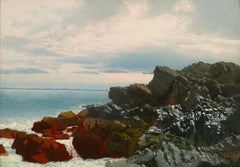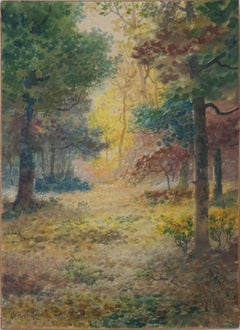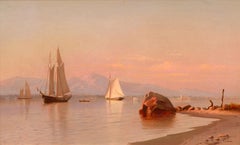William Bradford Art
to
5
3
5
2
3
Overall Height
to
Overall Width
to
5
5
3
2
2
1
1
1
1
1
1
1
1
1
1
1
5
5
6,827
3,114
2,517
1,217
5
5
2
2
2
Artist: William Bradford
Lights of the Aurora
By William Bradford
Located in New York, NY
Signed lower right: W Bradford
Category
Late 19th Century Hudson River School William Bradford Art
Materials
Oil, Board
Fishing Camp on the Labrador Coast
By William Bradford
Located in New York, NY
In 1852, twenty-nine year old William Bradford was a failing shopkeeper in Fairhaven, Massachusetts. With a wife and child at home, Bradford, by his own admission, “spent too much time in painting to succeed” in business. Rescued from insolvency by his well-to-do in-laws, this is not the beginning of a narrative that generally leads to a happy ending. Not so with Bradford, who ultimately found international fame and fortune as a painter of arctic seascapes and dramatic marine paintings.
William Bradford, the artist, was a lineal descendant of the 17th-century Separatist leader William Bradford, a founder of the Plymouth Plantation, signer of the Mayflower Compact and Governor of the Plymouth Colony. Our Bradford born to a New Bedford ship outfitter in Fairhaven, Massachusetts By the nineteenth century, this line of Bradfords were Quakers, living on the tract purchased nearly two centuries earlier by their pilgrim ancestor. Fairhaven, across the mouth of the Acushnet River from the whaling center of New Bedford was described by a New York journalist in 1857 as “the Brooklyn of New Bedford” (Home Journal, January 3, 1857). Young Bradford displayed an early predilection for the arts, but his Quaker parents were disinclined to support this particular pursuit. After working in his father’s business and then for a dry goods merchant in New Bedford, by 1849 Bradford had set up in New Bedford as a “merchant tailor” offering outfits for “those going to California,” “seamen’s clothing,” custom-tailored “piece goods...
Category
19th Century American Realist William Bradford Art
Materials
Canvas, Paper, Oil
Whiteface Mt, Lake Placid NY
By William Bradford
Located in Saratoga Springs, NY
Signed lower left
A 19th-century marine painter, William Bradford is famous for his seascapes that reflect his background of being raised in an area known for whaling and other marine activities. During much of his career, his work focused on the Arctic region, which he depicted with strong color and spectacular lighting.
Bradford was born and raised in New Bedford, Massachusetts to Quaker parents who disapproved of his desire for a painting career. He became a clerk in his father's dry goods shop in New Bedford but devoted his spare time to sketching, a diversion that caused him and his wife to lose a farm that had been given to them by his father-in- law.
In the early 1850s, living in Fairhaven, he launched his professional career by selling portraits of ships for twenty-five dollars a piece. In 1854, he opened a studio and about this same time attracted the interest of Albert Van Beest, a Dutch painter who had come to America in 1845. He became Bradford's teacher and collaborator, and until his death in 1860, they painted together local scenes including seascapes and whaling pictures.
In 1861, Bradford began a series of trips to Nova Scotia, Labrador, and Greenland, and painting and photographing the Arctic region became a consuming interest. He also published a book in London titled The Arctic Region, which he vividly illustrated with photographs pasted onto the page and he gave lectures accompanied by lantern slides...
Category
Late 19th Century Hudson River School William Bradford Art
Materials
Canvas, Oil
Rocky Shore
By William Bradford
Located in New York, NY
Signed lower right: W Bradford
Category
19th Century Hudson River School William Bradford Art
Materials
Oil
Fairhaven Harbor (Old Tack Works Wharf)
By William Bradford
Located in New York, NY
Signed lower right: Bradford
Category
19th Century Hudson River School William Bradford Art
Materials
Paper, Oil, Board
Related Items
1880s Original Hudson River School Landscape -- Sunset Through The Forest
By Charles Russell Loomis
Located in Soquel, CA
Beautiful Hudson River School Original gouache autumnal landscape of vivid sunset through forest by Charles Russell Loomis (American 1857 - 1936), circa 1880. Warm and cool tones wit...
Category
1880s Hudson River School William Bradford Art
Materials
Gouache, Paper, Cardboard
View on the Hudson, the Catskills in the Distance
By Francis Augustus Silva
Located in New York, NY
Signed lower right: F.A. SILVA.
Category
Late 19th Century Hudson River School William Bradford Art
Materials
Oil, Canvas
Texas Hill Country Landscape with Argemone, Coreopsis, and Flowering Cactus"
By Don Warren
Located in Austin, TX
A breathtaking Texas Hill Country landscape painted by American Plain Air painter, Don Warren. The painting is executed in oil on canvas and measures 18 by 24 inches. It is beautifully framed and ready to hang in a gold leaf frame that measures 25 by 31 inches.
The scene depicts a clear, idyllic summer day along trail through pastoral lands. A meadow of yellow coreopsis and white argemones make up the foreground, framing the focal point: prickly pair...
Category
Mid-20th Century American Realist William Bradford Art
Materials
Canvas, Oil
Highlands - Hudson River from West Point by Thomas B. Pope (American, 1834-1891)
Located in New York, NY
Painted by Hudson River School artist Thomas Benjamin Pope (1834–1891), "Highlands - Hudson River from West Point Looking North" is oil on canvas ...
Category
19th Century Hudson River School William Bradford Art
Materials
Board, Oil
Shawangunk Mountains by Lemuel Maynard Wiles (American, 1826-1905)
Located in New York, NY
Shawangunk Mountains [View from top of Granit Road Looking Southeast] by Hudson River School artist Lemuel Maynard Wiles (1826-1905) is oil on can...
Category
19th Century Hudson River School William Bradford Art
Materials
Board, Oil, Canvas
"Along the Kanahawa River, West Virginia, " Ernest Fiene, WPA Coal Steamboat
By Ernest Fiene
Located in New York, NY
Ernest Fiene
Along the Kanahawa River, West Virginia, 1936
Signed lower right
Oil on canvas
26 x 36 inches
Fiene made a series of paintings, drawings and lithographs which are based on his travels through Pennsylvania and West Virginia during the winter of 1935-36. The industrial areas of Pennsylvania and West Virginia are represented in numerous oils, among which are some of his most well-known. Fiene wrote of the trip, "The increasing snow and atmospheric conditions [in the Kanawha River valley} enhanced this mountainous coal mining country with a majestic beauty."
Winter on the River is Fiene's only American Artists Group print and there were only two lithographs produced from the West Virginia trip. The American Artists Group (AAG), under the direction of Carl Zigrosser, who was then working at New York's famed Weyhe Gallery, published ninety-three prints by over fifty artists in 1936 and 1937. Zigrosser's goal was to popularize contemporary American art through original prints offered at the low price of $2.75. The project was also a means to provide income for impoverished artists during the Depression. The prints were featured in many of the leading print exhibitions and publications of the period. The lithograph produced from this image is now in the collection of the Amon Carter Museum, Baltimore Museum of Art, Cleveland Museum of Art, Philadelphia Museum of Art, Pensacola Museum of Art, San Francisco Fine Arts Museum, Syracuse Museum, Yale University Art Museum.
Ernest Fiene was born in Elberfeld, Germany in 1894. As a teenager, Fiene immigrated to the United States in 1912. He studied art at the National Academy of Design in New York City from 1914 to 1918, taking day classes with Thomas Maynard and evening classes with Leon Kroll. Fiene continued his studies at the Beaux-Arts Institute of Design in New York from 1916 to 1918, adding classes in printmaking at the Art Students League in 1923.
Fiene began his career as an artist in 1919 with his first exhibition of watercolors at the MacDowell Club arranged by his mentor Robert Henri. In 1923 the Whitney Studio Club mounted a large exhibition of his works. The following year he had an exhibition at the New Gallery in New York, which completely sold out all fifty-two works, including paintings, watercolors, drawings, and etchings. With the proceeds of sales from the New Gallery exhibition, Ernest Fiene and his younger brother Paul, a sculptor, built studios in Woodstock, New York in 1925.
In the early Twenties Ernest Fiene painted mostly landscapes of Woodstock and both the Ramapo and Hudson River Valleys. The first monograph from the Younger Artists Series was published on Fiene in 1922. Published in Woodstock, the series went on to include Alexander Brook, Peggy Bacon, and Yasuo Kuniyoshi. The book reproduced 1 illustration in color and another 27 reproductions in black and white. Around 1925 Fiene became fascinated with the intensity, excitement, and opportunities for color harmonies New York City offered as a subject. His paintings shifted to urban and industrial themes with architecture, industry, and transportation becoming his subjects.
By 1926 Fiene had attracted the dealer Frank K.M. Rehn, who gave him a one-man exhibition that year, which travelled to the Boston Arts Club. C.W. Kraushaar Galleries gave Fiene a one-man exhibition of urban, landscape, portrait, and still life paintings in 1927. Julianna Force, the director of the Whitney Studio Club and first director of the Whitney Museum of American Art, included two of Fiene’s paintings in a fall exhibition in 1928. The Whitney Studio Club showed Fiene’s paintings in a two-man exhibition with Glenn O. Coleman that year and acquired three of Fiene’s paintings. Also in 1928 Fiene became affiliated with Edith Halpert’s Downtown Gallery where he had an exhibition of 20 lithographs in the spring. Fiene sold his house in Woodstock in 1928 to spend more of his time in New York City.
With so many successful exhibitions, Fiene returned to Paris in 1928-29 where he rented Jules Pascin's studio and studied at the Académie de la Grande Chaumière. In France, Fiene painted both landscape and urban subjects developed from ideas influenced by Cubist geometry and the use of flat areas of broad color. Upon returning to New York in 1930, Fiene used this new approach to continue to paint New York skyscraper and waterfront subjects, as well as to begin a series of paintings on changing old New York based on the excavations for Radio City Music Hall and the construction of the Empire State Building. Frank K.M. Rehn Galleries exhibited this series, titled “Changing Old New York,” in 1931. Fiene also has solo exhibitions at Rehn Galleries in 1930 and 1932. Fiene’s oil paintings are exhibited at the Chicago Arts Club in 1930 as well.
Fiene was included in the Museum of Modern Art’s exhibition Painting and Sculpture by Living Americans in December of 1931. Visiting New York, Henri Matisse saw the exhibition and called Fiene’s Razing Buildings, West 49th Street the finest painting he had seen in New York. Fiene had two mural studies from his Mechanical Progress series exhibited at the Museum of Modern Art’s exhibition Murals by American Painters and Photographers in 1932. Fiene sent View from my Window which depicts Fiene working on a lithograph stone while looking out his window to the newly completed Empire State Building to the Carnegie International in 1931. In 1932 Fiene participated in the first Biennial of American Painting at the Whitney Museum and his prints were included in exhibitions at the Downtown Gallery and the Wehye Gallery. In the same year, Fiene was awarded a Guggenheim fellowship to further study mural painting in Florence, Italy.
On his return from Italy in 1933 Fiene re-engaged himself in New York City life and won several public and private mural projects. Fiene resumed his active exhibition schedule, participating in two group exhibitions at the Whitney Museum and a one-man exhibition of recent paintings at the Downtown Gallery in January 1934. In 1933 he purchased a farm in Southbury, Connecticut, which added Connecticut scenes to his landscape subjects. This was also the year Fiene began to spend summers on Monhegan Island, Maine, where he painted seascapes, harbor scenes, and still lifes.
Fiene’s landscape paintings attracted numerous commissions as part of the American Scene movement. Through the fall and winter of 1935-36, Fiene took an extended sketching trip through the urban, industrial, and farming areas of Pennsylvania and West Virginia. Most of the twenty-four Pennsylvania urban and rural paintings from this trip were featured in an exhibition held at the First National Bank in Pittsburgh in October of 1937 by the Pittsburgh Commission for Industrial Expansion. Fiene said of these works that he formed rhythm, opportunity for space and color, and integrity in the Pennsylvania mill and furnace paintings. Fiene received the silver medal for one of the Pittsburgh paintings...
Category
1930s American Realist William Bradford Art
Materials
Canvas, Oil
Antique Oil Painting William Weaver Armstrong Mount Hood Oregon Landscape 1885
Located in Portland, OR
A large oil on Canvas painting by the California artist William Weaver Armstrong (1862-1906), Mount Hood Oregon landscape, circa 1885.
This large lan...
Category
1880s American Realist William Bradford Art
Materials
Canvas, Oil
Santa Monica Beach, 11AM
By Wes Hempel
Located in Fairfield, CT
Represented by George Billis Gallery, NYC & LA --A walk through any major museum will reveal paintings that depict or legitimate only certain kinds of experience. Despite the good in...
Category
2010s American Realist William Bradford Art
Materials
Canvas, Oil
Oil Landscape of Horizon at Sunset
Located in Fredericksburg, VA
Franklin Stanwood was born in Portland Maine and was raised by a captain. He was very self taught as he began his painting journey and practiced many di...
Category
Late 19th Century Hudson River School William Bradford Art
Materials
Board, Oil
19th Century White Mountain Landscape, Unknown American School
Located in Larchmont, NY
Unknown White Mountain Artist
White Mountain Landscape, 19th Century
Oil on board
5 x 9 1/4 in.
Framed: 7 3/4 x 11 3/4 in.
Category
19th Century Hudson River School William Bradford Art
Materials
Oil, Board
In the Sierras by Historic Woman Artist Kate W. Newhall (American, 1840-1917)
Located in New York, NY
Historic woman artist Kate W. Newhall's painting "In the Sierras" is oil on panel, measures 7 x 11 inches, and is signed at the lower left. The work is framed in an elegant, period a...
Category
19th Century Hudson River School William Bradford Art
Materials
Panel, Oil
diablo View
By Willard Dixon
Located in Burlingame, CA
‘Diablo View’ an original oil painting by American realist artist Willard Dixon, featuring distant rolling hills and expansive hazy blue sky. Willard Dixon has painted landscapes and...
Category
21st Century and Contemporary American Realist William Bradford Art
Materials
Canvas, Oil
William Bradford art for sale on 1stDibs.
Find a wide variety of authentic William Bradford art available for sale on 1stDibs. You can also browse by medium to find art by William Bradford in oil paint, paint, canvas and more. Not every interior allows for large William Bradford art, so small editions measuring 11 inches across are available. Customers who are interested in this artist might also find the work of William Trost Richards, William Rickarby Miller, and Jasper Francis Cropsey. William Bradford art prices can differ depending upon medium, time period and other attributes. On 1stDibs, the price for these items starts at $25,000 and tops out at $375,000, while the average work can sell for $50,000.





